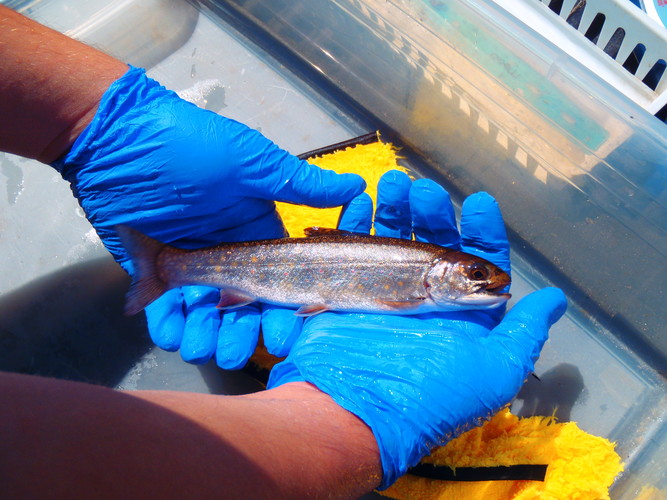The Wrack
The Wrack is the Wells Reserve blog, our collective logbook on the web.
The Wrack is the Wells Reserve blog, our collective logbook on the web.
In 2014, Wells Reserve researchers trapped and counted numerous brook trout in Branch Brook as part of an ongoing project to restore these native fish and the habitat they depend on (see previous blog post). We caught these fish as they moved from the estuary into the freshwater reaches of Branch Brook and ascended the restored fish ladder at the Water District filtration plant on Route 1. But other than the fact that they were in our net on a given date, we know very little about where they were before we caught them.
 Understanding why fish move in a river system is important for understanding how to improve the habitat they depend on. Brook trout will sometimes move from freshwater to the estuary, or even the open ocean, a behavior know as anadromy. Just like other anadromous species such as Atlantic salmon, these sea-run or "salter" brook trout will eventually return to freshwater to spawn. Populations of coastal sea-run brook trout have been impacted historically by the construction of head-of-tide dams that prevent them from reaching spawning areas, and as a result these populations have dwindled. The conservation organization Trout Unlimited recently produced a comprehensive report on the current status of sea-run brook trout, and identified Branch Brook as a location where more information on the current status of these populations is needed.
Understanding why fish move in a river system is important for understanding how to improve the habitat they depend on. Brook trout will sometimes move from freshwater to the estuary, or even the open ocean, a behavior know as anadromy. Just like other anadromous species such as Atlantic salmon, these sea-run or "salter" brook trout will eventually return to freshwater to spawn. Populations of coastal sea-run brook trout have been impacted historically by the construction of head-of-tide dams that prevent them from reaching spawning areas, and as a result these populations have dwindled. The conservation organization Trout Unlimited recently produced a comprehensive report on the current status of sea-run brook trout, and identified Branch Brook as a location where more information on the current status of these populations is needed.
 Our study will seek in part to answer the question of which fish are spending time at sea through the analysis of stable isotopes contained in their fins. The elements Carbon and Nitrogen exist in the environment in the form of different isotopes, and these vary between the marine and freshwater environments. When a brook trout spends time feeding at sea the marine isotopes of these elements are absorbed and fixed in the fish’s body tissues. Researchers can analyze tissue samples to detect which isotopes are present, and identify if a particular fish has spent time at sea. To carry out this analysis Wells Reserve researchers collected fin clips from each brook trout that was sampled in 2015. This non-lethal sampling is different from traditional isotopic analysis which has relied on collection of the ear bone, known as the otilith. Wells Reserve has partnered with researchers at Bates College who have experience with this novel technique and will conduct the actual lab analysis.
Our study will seek in part to answer the question of which fish are spending time at sea through the analysis of stable isotopes contained in their fins. The elements Carbon and Nitrogen exist in the environment in the form of different isotopes, and these vary between the marine and freshwater environments. When a brook trout spends time feeding at sea the marine isotopes of these elements are absorbed and fixed in the fish’s body tissues. Researchers can analyze tissue samples to detect which isotopes are present, and identify if a particular fish has spent time at sea. To carry out this analysis Wells Reserve researchers collected fin clips from each brook trout that was sampled in 2015. This non-lethal sampling is different from traditional isotopic analysis which has relied on collection of the ear bone, known as the otilith. Wells Reserve has partnered with researchers at Bates College who have experience with this novel technique and will conduct the actual lab analysis.
Once this analysis has been carried out, the information will be used to help guide further sampling in Branch Brook. As more information is gathered on the status of sea run brook trout in our estuary it will add to our understanding of how these populations are responding to restoration work in the watershed.